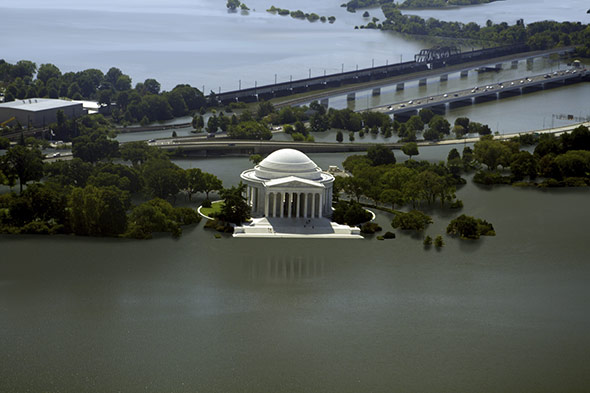Slate.com shows us what global warming has in store for us. In Washington, DC, the Jefferson Memorial goes underwater along the tidal basin and the tidal Potomac. Your kiddies had better go to the National Mall on their eighth grade class trip, because by the time the grandkids come along it ain't gonna be there no more.
The National Capital Planning Commisson is all over it. They are out to save the monuments, like yesterday. We are already suffering right now.
The Tidal Basin of the National Mall is one of the most photographed and visited landscapes in Washington. It is also an example of how climate change is effecting the National Capital Region. Scientists and arborists are noting that the cherry trees are blooming sooner each decade with the earlier arrival of warm spring temperatures. More frequent and intense storm events cause ponding of water along the basin's walks. The Tidal Basin reminds us that our infrastructure systems, including roads, rails, bridges, sewers, power grid, and water lines are vulnerable to the changing climate. We need to understand the impacts of these changes and to work collectively to ensure the resiliency of the National Capital.For proof they show us a picture of the ponding.
In the National Capital Planning Commission's confirming photo, the Potomac tidal basin overruns the seawall on the west side of Jefferson Memorial (to the right in the top picture). It's so bad that the blooming cherry trees are marooned and a new walkway installed twenty yards inland (left edge) from its original location. My, if that isn't real evidence of the destructive impact of rising oceans, then what is?
Except for one thing that they neglected to mention -- like the facts, as reported by the Washington Post when it still had some pretense to being an actual newspaper.
The big problem seems to be a section of the sea wall that is breaking from the memorial's plaza and settling into the Tidal Basin. The "ring road" along the memorial's circumference also seems to be shifting, officials say.
Such movement is an alarming -- and chronic -- problem at the Jefferson Memorial, which was built in the late 1930s and early 1940s atop pilings and caissons sunk into an artificial mud flat that is about 100 feet deep. Engineers have been struggling for decades to keep everything firmed up.
Efforts are being made to save the portions of the seawall immediately adjacent to the memorial.
The brown goo oozed from the drill hole like a primordial porridge -- from 60 feet beneath the Jefferson Memorial, it was some of the muck that's under the Mall and part of the stuff that has been slowly swallowing the memorial's sea wall for years.
Centuries of Potomac River sediment and layers of dredged fill, it is the material engineers are drilling through to reach bedrock and anchor the famed memorial's sea wall, for the first time, on a solid foundation.It's a man made problem for sure, but the men were engineers who did an inadequate job decades back.
In a bit of engineering detective work, experts have discovered that the wall has been slipping away from the memorial's north plaza because the timber pilings that were used to support the wall were probably not long enough to reach bedrock when the memorial was built in the 1930s and '40s.
Studying old photos, engineers were able to determine that the piles were about 65 to 75 feet long, although bedrock starts about 80 feet down, National Park Service civil engineer Steven D. Sims said.
The walkway actually floods, twice a day, at high tide and at high tide. The inner loop curving around to the memorial has been abandoned.
Except for the seagulls and ducks.
Most of the walkway around the tidal basin was built decades before the sections adjacent to the Jefferson Memorial and is in no danger of flooding except for a few days once every decade of two, when a tropical system wanders up the Potomac.
Remember, it's science. Good luck to all.



No comments:
Post a Comment